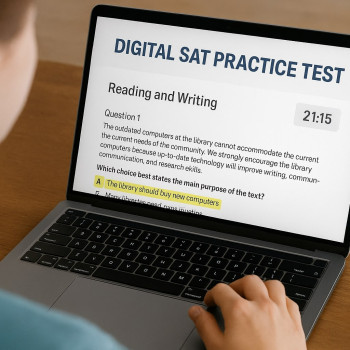Why this matters: two question types, one math section
If you’re prepping for the Digital SAT, you’ve probably noticed that the Math section isn’t just a single flavor of question. Two important types show up repeatedly: problem-solving & data analysis questions (the multiple-choice, context-heavy items that often read like mini word problems) and student-produced response questions—often called grid-ins—where you produce your own numerical answer. Understanding how these two question types differ is less about trivia and more about strategy. Nail the differences, and you’ll move from guessing to confident solving.
Quick snapshot: What are problem-solving vs. grid-in questions?
Problem-solving & data analysis (multiple-choice)
These are the context-driven questions where you’re given a scenario—a recipe, a graph, a business problem—and asked to apply ratios, rates, percentages, or data interpretation to find an answer. You’ll typically see four answer choices and the usual multiple-choice logic applies: sometimes you can use elimination, sometimes you can plug in numbers, and sometimes the simplest algebra wins.
Student-produced response (grid-in)
Grid-ins ask you to generate an answer yourself and enter it into an on-screen grid. There are no answer choices to lean on, no traps set by tempting wrong choices. That freedom means greater responsibility: the SAT expects you to show precision, careful arithmetic (or neat algebra), and deliberate work. On the Digital SAT, you type your numeric response into a field near the question.
What the test is actually measuring
Both formats probe the same core skills: algebra, advanced math, geometry/trigonometry, and—crucially—problem-solving and data analysis. But they emphasize slightly different abilities.
Problem-solving emphasis
- Translating real-world language into math (word problems).
- Interpreting graphs, tables, and statistical text.
- Picking the most effective method quickly—estimation, unit analysis, or algebra.
- Using answer choices strategically (plugging in, eliminating).
Grid-in emphasis
- Setting up and completing multi-step computations without choice cues.
- Maintaining precision (fractions, simplified radicals, or exact decimals when required).
- Recognizing when an exact form is required versus when a rounded decimal is acceptable.
- Managing arithmetic errors—because there are no answer choices to mask them.
Practical differences that change how you approach the question
Knowing the theoretical difference is useful, but what really helps is understanding how that difference changes your approach in the moment.
1) Strategy tools you can use
- Multiple-choice: Backsolving (plugging answer choices into the problem) and elimination can save time.
- Grid-in: Work forward from a carefully set-up equation; double-check your work, and when possible, do a quick sanity check (estimate) to make sure your numeric answer is plausible.
2) Mistake margin
Multiple-choice sometimes hides small calculation errors—the correct choice can still pop out. Grid-ins expose them. One small slip and your answer is wrong. That means slower, cleaner work can beat faster, sloppy work on grid-ins.
3) Time management
Because grid-ins demand clean work, they can take longer. Consider alternating: answer quicker multiple-choice items first (especially the ones you can do mentally or with a quick plug-in) and save grid-ins for a dedicated, focused pass.
Smart strategies for problem-solving (multiple-choice)
Read, translate, and predict
Before you touch the answers, read the stem, translate to math, and predict a rough magnitude for the answer. If your prediction is “around 30,” watch answer choices that are 3,000 or 0.03—those can often be eliminated immediately.
Use the answer choices
If algebra looks messy, try plugging choices in—especially when variables are in denominators or the question asks which choice could be true. Plugging speeds you to a result without messy symbolic algebra.
Estimation and bounds
When exact arithmetic is tedious, estimate. If the problem asks about a percent increase and your estimate is 7%, choices like 3% or 50% can be thrown out instantly. Estimation is a top-tier time-saver on these questions.
Smart strategies for grid-ins (student-produced responses)
Set up clearly, then compute
Start by writing a one-line setup: what you’re solving for and the equation or relationship you’ll use. That keeps you from losing the path mid-calculation.
Keep an eye on acceptable formats
SAT grid-ins often accept a few equivalent formats (for example, 1/2 and 0.5). However, certain forms like repeating decimals can be tricky to enter. When in doubt, put exact fractions or simplified radicals if the problem’s nature suggests exact values.
Sanity-check with a quick estimation
After you compute, round your answer and check it against a predicted range. If your computed answer is 12.873 but your mental prediction was ~1300, you likely dropped a power of ten somewhere.
Common student errors—and how to avoid them
- Dropping negative signs: Circle negatives in the problem and in your setup.
- Mixing up units: Pay attention to units; convert before you compute.
- Rushing arithmetic: Use scratch space to keep operations neat, especially for grid-ins.
- Forgetting domain restrictions: Check denominators and square roots—some values are invalid.
How to practice: targeted drills and a weekly plan
Practice isn’t just quantity; it’s intentionality. You want drills that simulate the cognitive patterns of each question type.
Weekly practice plan (example)
| Day | Focus | Duration | Why it helps |
|---|---|---|---|
| Monday | Multiple-choice problem-solving (12 questions) | 60 minutes | Build speed with translating word problems and elimination techniques |
| Wednesday | Grid-in practice (8 questions) | 60 minutes | Focus on precise setups and arithmetic accuracy |
| Friday | Mixed set (timed section-simulation) | 75 minutes | Train switching between formats under time pressure |
| Weekend | Review mistakes + conceptual drills | 90 minutes | Fix recurring errors and deepen understanding |
Consistency beats cramming. Aim for repeating this cycle for 6–8 weeks before a target test date, adjusting volume as you improve.
Practice techniques that actually move your score
1) Focused error logs
Keep a one-page error log for both question types. Note: the question topic, your approach, the mistake type (conceptual, arithmetic, silly), and a corrected method. Over time patterns will emerge—maybe fractions trip you up, or you tend to forget to square when needed.
2) Timed micro-sessions
Do five 10-minute timed bursts focused only on grid-ins. The goal is not finishing every question but learning to set up cleanly and avoid common slips under mild time pressure.
3) Build number sense
Develop estimation habits: round complex numbers, use compatible numbers for quick mental checks, and practice translating common percentages into fractions in your head (e.g., 12.5% = 1/8).
How calculators fit in—especially for the Digital SAT
On the Digital SAT you’ll often use the Desmos-like calculator built into Bluebook, or an approved handheld model. The key is familiarity. If you plan to use the on-screen calculator, practice with it so switching between mental math and calculator inputs is seamless.
Calculator do’s and don’ts
- Do know how to switch modes (scientific vs. graphing) quickly on the test tool.
- Don’t rely on it for basic arithmetic—you’ll waste valuable time entering simple calculations.
- Do use it for messy algebra, large exponent manipulations, or checking final arithmetic on grid-ins.
Sample questions and how to think through them (condensed practice)
Multiple-choice sample (problem-solving)
Imagine a question about a water tank that loses 3% of its volume each hour. You’re asked to choose the fraction of the original volume remaining after 5 hours. Before writing an equation, estimate: 3% per hour is small, so remaining should be in the neighborhood of (0.97)^5 ≈ 0.86. Now check the choices and pick the one nearest to 0.86—if one choice is 86/100 (0.86) or simplified 43/50, you’re good. If algebra looks messy, your estimate does the heavy lifting fast.
Grid-in sample
Suppose a question asks: “A recipe calls for 3/4 cup of sugar per batch. If a baker needs 15 batches, how many cups of sugar are required?” Here you must produce the numeric answer. Set up: (3/4)*15 = 45/4 = 11.25 cups. Enter as 11.25 or 45/4 if both formats are acceptable—be consistent with what the prompt suggests (if it asks for a numerical value in decimals, enter 11.25). Quick sanity check: 15 batches × ~0.75 ≈ 11.25 —looks right.
When to guess and when to invest extra time
Guessing strategies differ between the formats. On multiple-choice items, educated guessing—eliminating one or two bad answers—can give you decent odds. On grid-ins, guessing is riskier since there’s no partial clue from choices.
Practical rule of thumb
- If you can get a rough estimate or eliminate answers in 30–60 seconds, invest the time on multiple-choice.
- For grid-ins, if after 90 seconds you don’t have a clean setup, move on and flag the question to return to with fresh focus—often a re-start helps you notice what you missed.
Real-world context that makes the math feel less abstract
Think of problem-solving questions like word puzzles about life: money, rates, plans, and measurements. Grid-ins are the times you’re asked to produce a final number—like how much paint you need for a wall. Framing problems with everyday activities (budgeting, baking, trip planning) not only makes them more relatable but also trains your intuition for reasonable answers.
How personalized help accelerates this process
Everyone’s sticky spots are different—maybe you understand ratios perfectly but lose points on arithmetic accuracy in grid-ins. That’s where targeted, individualized guidance pays off. One-on-one tutoring helps because a tutor can diagnose the exact mistake pattern and give practice tailored to fix it. Sparkl’s personalized tutoring, for example, pairs students with expert tutors who create tailored study plans, offer 1-on-1 guidance, and use AI-driven insights to adjust practice—so your time is spent on the topics that yield the biggest score gains.
Checklist for the last month before test day
- Complete at least two full timed practice sections in Bluebook to simulate the testing environment.
- Log every mistake and turn the top five recurring errors into a focused mini-drill set.
- Do three grid-in practice drills per week, emphasizing clean setup and sanity checks.
- Get comfortable with the built-in calculator by practicing with it exclusively for a week.
- Schedule at least one session of targeted one-on-one tutoring to refine strategy and receive personalized feedback.
A final word on confidence and mindset
Technical skills matter, but so does the way you show up. Approach grid-ins calmly—think of them as short puzzles you control. Approach multiple-choice with playful skepticism: the test writers might try to rope you into thinking a tempting answer is correct. Practice enough that your instincts become reliable, and use checklists to steady your nerves (unit checks, sign checks, reasonableness checks).
Short practice mantra before every Math module
Read calmly. Translate cleanly. Predict roughly. Compute carefully. Check quickly.
Wrapping up: make your preparation intentional
The Digital SAT’s Math section rewards clarity of thought more than speed. Understanding the difference between problem-solving multiple-choice items and grid-ins lets you pick the right tool for each job—whether that’s estimation, backsolving, or meticulous algebra. Build a study routine that alternates speed and precision work, log your errors, practice with the test’s digital tools, and consider targeted one-on-one guidance to eliminate persistent errors. With steady practice and smart strategy, both problem-solving and grid-in questions will stop being intimidating and start being opportunities to show what you truly know.
Good luck — and remember: every mistake fixed in practice is peace of mind on test day.
















No Comments
Leave a comment Cancel